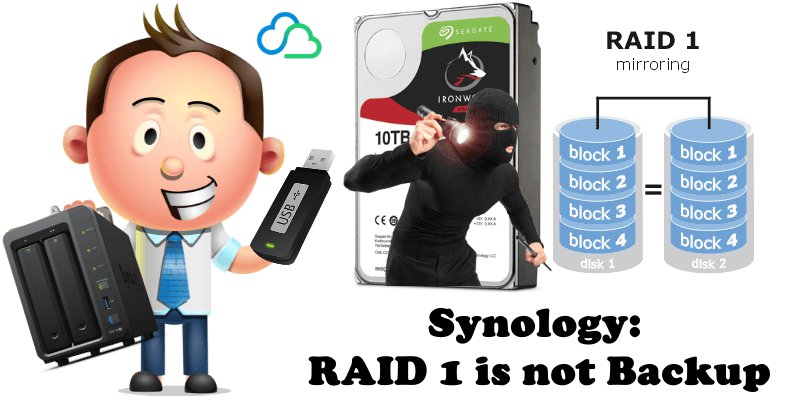
What is RAID 1? On Synology Nas, RAID 1 is most often implemented with two drives. Data on the drives are mirrored, providing fault tolerance in case of drive failure. Read performance is increased while write performance is similar to that of a single drive. A single drive failure can be sustained without data loss. RAID 1 is often used when fault tolerance is key, and space and performance are not critical requirements. To be clear, RAID 1:
- Writes identical data to all drives simultaneously.
- Provides data redundancy. (In computer main memory, auxiliary storage and computer buses, data redundancy is the existence of data that is additional to the actual data and permits correction of errors in stored or transmitted data.)
RAID 1 isn’t a substitute for backup because there are a lot of risks that it can’t protect against. For example, if you accidentally delete a file, it will instantly be removed from both mirrored copies. If your disk is corrupted by a software bug or virus, the corruption will occur to both mirrored copies simultaneously. If you’re hit by a strong enough power surge, it’ll probably fry both disks at the same time. If someone breaks into your house, they’ll steal your Synology Nas that holds both disks. If your house gets flooded or burned down, both disks will be ruined. RAID is not backup & backup is not RAID.
Note: RAID 1 will ONLY protect you against a hardware failure, NOT data corruption. To be clear, RAID 1 protects against hardware failure only. It does not protect against user error, natural disasters etc. Backups provide you snapshots of your data at any point in time in the past. Obviously, the more copies you keep in different locations, the safer your data is.
Note: RAID 1 is not a substitute for a backup, but it can be used as a system for backing up. To make a backup, remove one of the disks and replace it with a blank disk. The disk that you removed becomes your back up and the new blank disk will be mirrored thanks to the first disk.
Best Synology Backup Strategy:
- Create a local copy: This could be an USB flash drive, an external HDD/SSD, an HDD/SSD in your desktop PC or in another Synology Nas that is dedicated to backup. If your main box fails, you can restore data from the backup. If you lose a file you can restore it. A local backup copy allows you to perform a quick restore. There are many ways to backup your data but Synology’s Hyper Backup package is the best.
Note: A local backup is not a complete solution – you are still vulnerable to floods, fires and theft because, chances are, whatever disaster may affect your main box, it will affect the backup device too.
- Create off-site backup: To complete your backup strategy you need an off-site copy using a cloud service. Hyper Backup can connect to Google Drive, Amazon Drive, Dropbox, Microsoft Azure, S3-compatible storage, and Synology C2, a cloud backup service dedicated to Synology users. I use the Synology C2 service because I prefer to use Synology technology across the entire backup process.
Note: Snapshot Replication is not a Backup!
This post was updated on Monday / August 10th, 2020 at 1:31 AM
